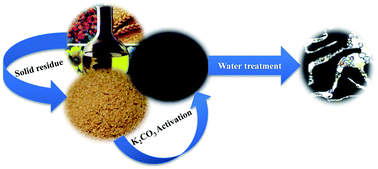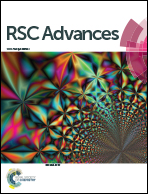Biodiesel production waste as promising biomass precursor of reusable activated carbons for caffeine removal†
Abstract
Biodiesel production generates low particle size rapeseed waste (recovered from warehouse air filtration systems) that was herein explored as promising biomass precursor of chemically activated carbons. The influence of several experimental parameters on the porosity development was investigated. No benefit was observed when solution impregnation was made nor a significant dependence of the biomass : K2CO3 ratio was observed and, as expected, high porosity development was obtained only for treatments at 700 °C. Microporous materials with apparent surface area around 1000 m2 g−1 were obtained comparing favorably with literature data regarding activated carbons from rapeseed processing by-products. A selected lab-made sample and two commercial carbons were tested as adsorbents of caffeine from aqueous solution. Although commercial materials present a quicker adsorption rate, regarding adsorption capacity the lab-made sample reaches the same value attained by a benchmark material. The regeneration tests made over the rapeseed derived carbon through heat treatments at 600 °C for 1 hour under N2 flow proved that at least two exhaustion–regeneration cycles can be made since the material retains a caffeine adsorption capacity similar to that of the fresh carbon. Therefore, a waste management problem of biodiesel industry – rapeseed residue – can be transformed in a valuable material with promising properties for environmental remediation processes.



 Please wait while we load your content...
Please wait while we load your content...